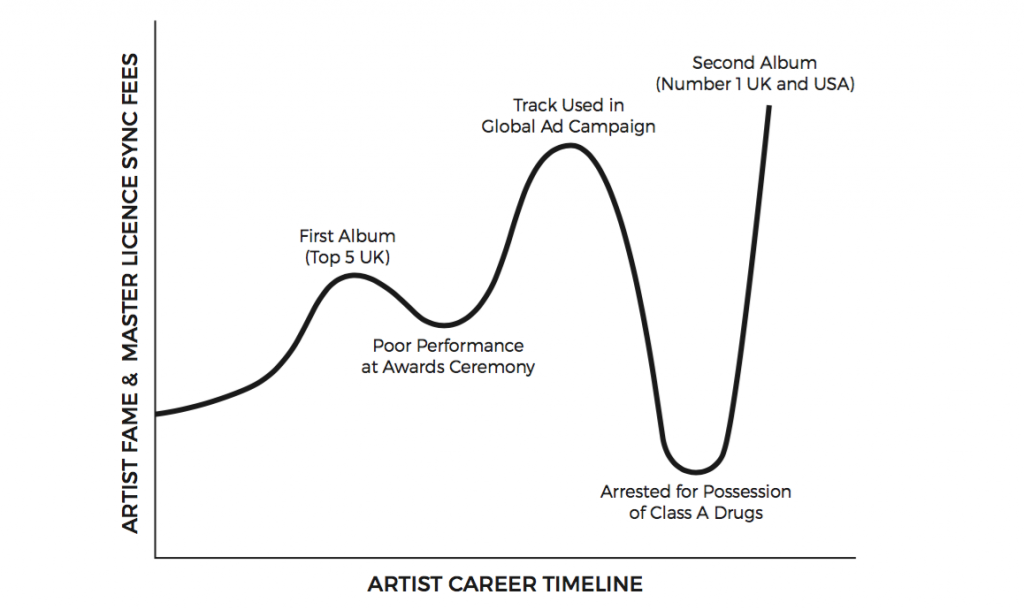 Songs often have a life of their own and tend to be immune to changes in the reputation of their songwriters. In contrast, the value of sound recordings is more closely linked with the reputation of recording artists.
Songs often have a life of their own and tend to be immune to changes in the reputation of their songwriters. In contrast, the value of sound recordings is more closely linked with the reputation of recording artists.
Fame can be fickle, though it tends to affect artists more than songwriters. Think of it as an index, like the FTSe100.
(i) Songs And Songwriters
The beauty of music publishing is that great songs live forever – or at least it can seem that way. These songs are often called “classics”, “standards” or “evergreen copyrights”. Songs like these tend to have been recorded and performed by many different artists and so command a huge premium in the sync licensing market.
Given that in most EU States the life of copyright in songs is seventy years after the death of the songwriter, this high value lasts a long time. As a few examples, think of the amazing song catalogues of Cole Porter (“Night & Day”, “I Get A Kick out of you”), Rodgers and Hammerstein (“oh what A Beautiful Morning”, “The Surrey with A Fringe on Top”) and Bacharach and David (“Raindrops Keep Falling on My Head, “I Say A little Prayer”). I’d argue that their songs will still be famous in another fifty years and possibly longer. of course they will eventually fall out of copyright, but while they’re in copyright the market value of those songs and their songwriters will remain very high in the sync licensing market.
What does this mean for marketers?
Even for current songwriters, the perceived value of their songs is often not affected by the ups and downs of their careers as artists (if the songwriter is also an artist). The songs have a life of their own, especially when covered by another artist.
(ii) Recordings and artists

The value of recordings is more likely to vary with the peaks and troughs in the artist’s career, compared with the songs written by the same person.
With social media able to report and instantly share the slightest misdemeanour of a famous artist, brands have to consider possible reputational damage by association. The popular media loves to build artists up then knock them down, so bad behaviour is newsworthy. If a brand is negotiating the use of a recording by an artist who’s exposed in this way, arguably the value of that recording may fall if far fewer brands are brave enough to still use it. However, sometimes it can go the other way, where notoriety increases the value. It depends on the brand and whether it seeks or recoils from the edginess associated with some artists.
In addition to artist behaviour, sales of the artist’s recorded music will affect sync value. let’s consider the “difficult second album” syndrome. It’s not uncommon for tracks from a successful first album to attract a high value in the sync market, especially where that album achieved gold* or platinum* status and/or a top five position in the album charts. However, where the second album fails to live up to sales expectations, those newer recordings are likely to attract lower sync fees, especially as both artist and record label will be very keen to secure the exposure from brand campaigns.
What does this mean for marketers?
If you’re looking to use a recording by a current artist, ask yourself, “Are they darlings of the media or in the dog house for recent bad behaviour?”
If you’re looking to use a recording by an established artist, where are they in the arc of their career? Would a brand campaign help to rejuvenate interest in their catalogue?
Consider these points carefully to understand the leverage that you have with the record label who controls the sound recording you wish to license.
Given that some music artists occasionally indulge in anti-social or even illegal behaviour, it’s wise to have “death and disgrace” insurance in place to mitigate risk should you need to rapidly terminate an artist relationship or use of their music track.
Key Takeaways For Marketers
- Songs, especially famous ones, have a life of their own
- The value of songs can be immune to the songwriter’s reputation
- Recordings are more closely linked to artist who made them
- The value of recordings may fluctuate with the artist’s reputation
- Brands should be aware of an artist’s career cycle to understand value
* In the UK, currently sales of 100,000 albums denotes gold status and 300,000 albums denotes platinum status as certified by the British Phonographic Industry (“BPI”).
This post is an extract from my book Music Rights Without Fights.